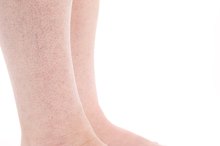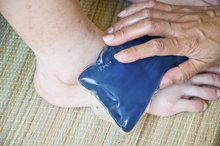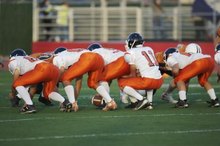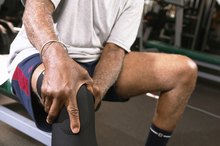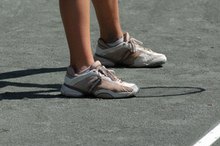Unexplained Shooting Pain in My Shins
Whether you are an athlete or participate in regular exercise, your lower extremities endure a tremendous amount of stress with each move you make. As a result, pain along your shin bones may occur. While pain may seen unexplained at times, there are numerous causes of shin pain. The most common cause is shin splints -- or medical tibial stress syndrome. Shin splints are common in dancers, runners and military personnel 1. If you experience unexplained shin pain, discontinue exercise and contact your doctor.
If you are experiencing serious medical symptoms, seek emergency treatment immediately.
Medial Tibial Stress Syndrome
Medial tibial stress syndrome causes pain and inflammation along the inside edges of your tibia -- or shin bone. The pain is normally worse with participation in physical activity and tends to subside with rest. You may experience mild swelling in your lower leg as well. If you rest, your pain will likely subside. Runners, dancers, those with flat feet, individuals who participate in sports on hard surfaces and those in military training are at a higher risk for developing shin splints. If you suddenly increase your training regime, you are also at a higher risk for developing shin splints.
- Medial tibial stress syndrome causes pain and inflammation along the inside edges of your tibia -- or shin bone.
- Runners, dancers, those with flat feet, individuals who participate in sports on hard surfaces and those in military training are at a higher risk for developing shin splints.
Diagnosis
What Causes Pain to the Back of Your Ankle & Heel When You Walk?
Learn More
If you experience persistent shin pain, you should make an appointment with an orthopaedic or sports medicine doctor. Shin splints are diagnosed with a medical history and physical examination. Your doctor may order an X-ray, a CT scan or an MRI to rule out or make a diagnosis of another condition, including tendinitis or a stress fracture.
Treatment
It can take several weeks for shin splints to heal. Rest is the number one treatment method for shin splints. You should avoid the activity that caused your injury. With your doctor's permission, you may participate in low-impact exercise such as swimming or cycling. Your doctor may also recommend anti-inflammatory medications, stretching exercises, mild compression and the use of ice packs. Surgery is rarely required for shin splints.
- It can take several weeks for shin splints to heal.
- Rest is the number one treatment method for shin splints.
Other Considerations
Dull Aches in the Shin
Learn More
Shin splints are not the only reason for unexplained shin pain. Your shin pain may be the result of a stress fracture. A stress fracture created tiny fractures in your bone as the result of overuse. Symptoms are similar to shin splints. An MRI is need to show the presence of shin splints. You may also have tendinitis -- which is an inflammation of the tendons surrounding your shin bone. An uncommon condition that causes shin pain is known as chronic exertional compartment syndrome. This condition creates excessive swelling and muscle pressure in your lower legs. The swelling and pressure can prevent blood from flowing to your legs. This condition requires surgery.
- Shin splints are not the only reason for unexplained shin pain.
Related Articles
References
- MayoClinic.com; Shin Splints; December 21, 2010
- American Academy of Orthopaedic Surgeons; Shin Splints; August 2007
- McClure CJ, Oh R. Medial Tibial Stress Syndrome. [Updated 2019 Apr 4]. In: StatPearls [Internet]. Treasure Island (FL): StatPearls Publishing; 2020 Jan-. Available from: https://www.ncbi.nlm.nih.gov/books/NBK538479/
- McClure CJ, Oh R. Medial Tibial Stress Syndrome. [Updated 2019 Apr 4]. In: StatPearls [Internet]. Treasure Island (FL): StatPearls Publishing; 2020 Jan-.
- Winters M. The diagnosis and management of medial tibial stress syndrome : An evidence update. Diagnostik und Therapie des Schienbeinkantensyndroms : Update zur Studienlage. Unfallchirurg. 2020;123(Suppl 1):15‐19. doi:10.1007/s00113-019-0667-z
- Galbraith RM, Lavallee ME. Medial tibial stress syndrome: conservative treatment options. Curr Rev Musculoskelet Med. 2009;2(3):127‐133. Published 2009 Oct 7. doi:10.1007/s12178-009-9055-6
- Franklyn M, Oakes B. Aetiology and mechanisms of injury in medial tibial stress syndrome: Current and future developments. World J Orthop. 2015;6(8):577‐589. Published 2015 Sep 18. doi:10.5312/wjo.v6.i8.577
- Franklyn M, Oakes B. Aetiology and mechanisms of injury in medial tibial stress syndrome: Current and future developments. World J Orthop. 2015 Sep 18;6(8):577-89. doi: 10.5312/wjo.v6.i8.577
- Bonasia DE, Rosso F, Cottino U, Rossi R. Exercise-induced leg pain. Asia Pac J Sports Med Arthrosc Rehabil Technol. 2015;2(3):73‐84. Published 2015 May 2. doi:10.1016/j.asmart.2015.03.003
- Arnold MJ, Moody AL. Common Running Injuries: Evaluation and Management. Am Fam Physician. 2018 Apr 15;97(8):510-16.
- Rankin A. An Evidence-Based Case Study of Unilateral Shin Splints: Do Red Flags Function in Paediatric Osteosarcoma? Physiother Can. 2015 Fall;67(4):365-68. doi: 10.3138/ptc.2014-79
- Winters M, Eskes M, Weir A, Moen MH, Backx FJ, Bakker EW. Treatment of medial tibial stress syndrome: a systematic review. Sports Med. 2013;43(12):1315‐1333. doi:10.1007/s40279-013-0087-0
- Craig DI. Medial tibial stress syndrome: evidence-based prevention. J Athl Train. 2008;43(3):316‐318. doi:10.4085/1062-6050-43.3.316
Writer Bio
Michelle Zehr started writing professionally in 2009. She has written on health, fitness, fashion, interior design, home decorating,sports and finance for several websites. Zehr possesses a Bachelor of Arts in communication from the University of Pittsburgh, a Master of Arts in professional writing from Chatham University and a graduate certificate in health promotion from California University of Pennsylvania.

